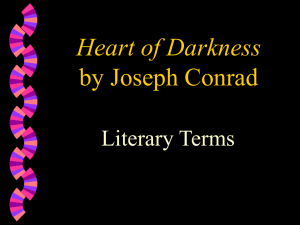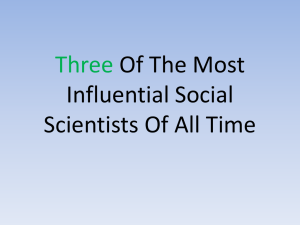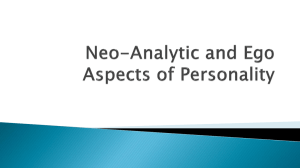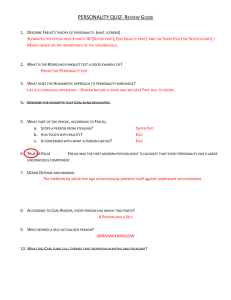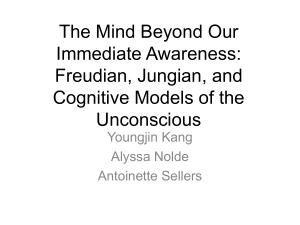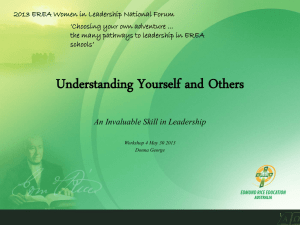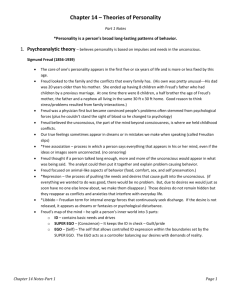The psychoanalytic paradigm Carl jung
advertisement
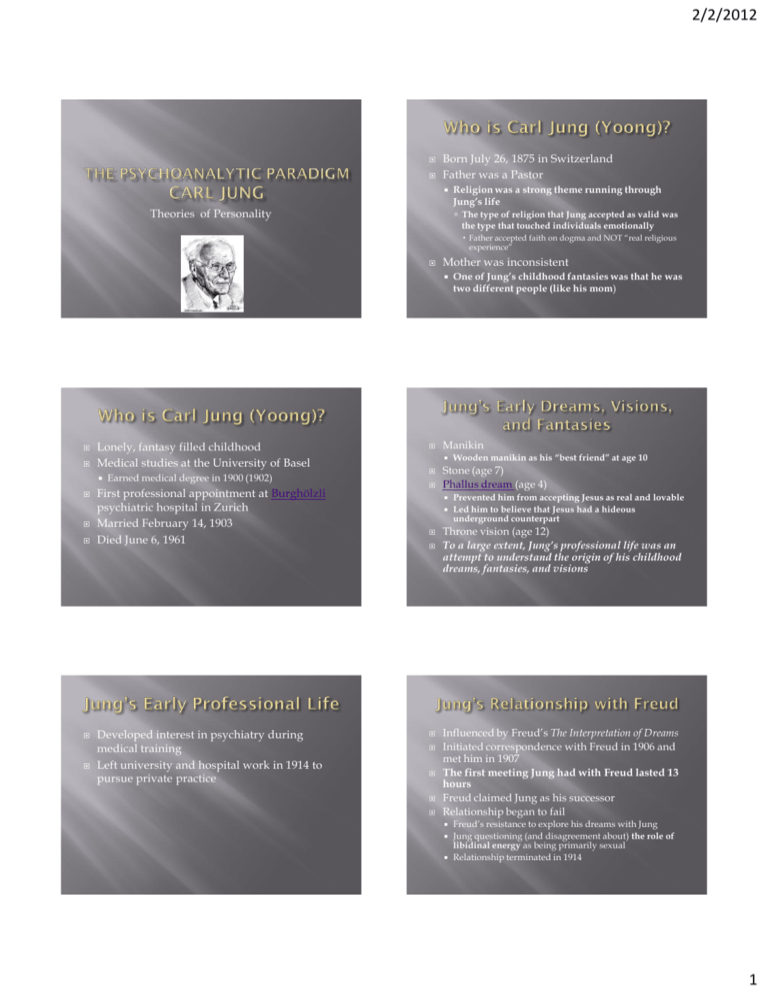
2/2/2012 Born July 26, 1875 in Switzerland Father was a Pastor Theories of Personality Religion was a strong theme running through Jung‟s life The type of religion that Jung accepted as valid was the type that touched individuals emotionally Father accepted faith on dogma and NOT “real religious experience” Mother was inconsistent Lonely, fantasy filled childhood Medical studies at the University of Basel Earned medical degree in 1900 (1902) First professional appointment at Burghölzli psychiatric hospital in Zurich Married February 14, 1903 Died June 6, 1961 Developed interest in psychiatry during medical training Left university and hospital work in 1914 to pursue private practice Manikin Wooden manikin as his “best friend” at age 10 Stone (age 7) Phallus dream (age 4) One of Jung‟s childhood fantasies was that he was two different people (like his mom) Prevented him from accepting Jesus as real and lovable Led him to believe that Jesus had a hideous underground counterpart Throne vision (age 12) To a large extent, Jung’s professional life was an attempt to understand the origin of his childhood dreams, fantasies, and visions Influenced by Freud‟s The Interpretation of Dreams Initiated correspondence with Freud in 1906 and met him in 1907 The first meeting Jung had with Freud lasted 13 hours Freud claimed Jung as his successor Relationship began to fail Freud‟s resistance to explore his dreams with Jung Jung questioning (and disagreement about) the role of libidinal energy as being primarily sexual Relationship terminated in 1914 1 2/2/2012 Often referred to as Jung‟s “dark years” His “creative” illness was, perhaps, precipitated by the break with Freud He emerged from these dark years with his own unique theory of personality Libido The total amount of psychic energy is fixed “If one component of the psyche is overvalued, it is at the expense of the other components” Principle of Entropy (from second law of thermodynamics*) For Jung, a creative life force Libidinal energy is applied to the satisfaction of both biological and spiritual needs Driving force behind the psyche (personality) Principle of Equivalence (from first law of thermodynamics*) Jung continued to write and develop his theory until is death at age 86 Many Jungian societies exist throughout the world today as his theory has remained popular Tendency for all components of the psyche to have equal energy Principle of Opposites Every concept in Jung‟s theory has a polar opposite “Everything carries within itself its own negation” *The principle of thermodynamics states that the amount of energy in a system is essentially fixed and if it is removed from one part of a system it will surface in another Conscious Unconscious Rational Irrational Masculine Feminine Animal Spiritual Thinking Feeling Sensing Intuition The goal is balance, but is rarely achieved Ego Personal Unconscious Collective Unconscious Archetype 2 2/2/2012 Ego Everything of which we are conscious Personal unconscious Thinking, perceiving, feeling, remembering Main task: carry out life functions Responsible for our sense of identity Similar to Freud‟s concept of ego Material that was once conscious but was repressed or forgotten Complex: Personally disturbing constellation of ideas connected by common feeling or „theme‟ Complexes should be identifiedas they use excessive psychic energy and inhibit balanced psychological growth Development of the word-association test (to study complexes) Demonstrated that it was possible to systematically study the unconscious mind Child Green Water Sing Death Long Stupid Collective unconscious It is essentially the same for all individuals “deposit of ancestral experiences from untold millions of years, the echo of prehistoric world events to which each century adds an infinitesimally small amount of variation and differentiation” (page 74) Archetypes: inherited tendencies to respond to common life experiences Develop in response to universal experiences Persona: One‟s public self Anima: Female component of the male psyche What must every human being experience? water, pain, mother, father, heroes, magic Myths (ex: sun hero myth) Myths associated with the emotional experiences of our ancestors are passed on to future generations as archetypes Most mystical and controversial concept Jung believed it to be the most important and influential part of the psyche (the heart of his theory) Archetypes Birth, death, the sun, darkness, women, men, sex, Collective experiences from human evolutionary past Develops because of need to play a role in society Develops from the experiences men have had with women throughout time Causes males to have feminine traits Provides a framework within which males interact with females Animus: Masculine component of the female psyche 3 2/2/2012 Shadow: Darkest, deepest part of the psyche Inherited from pre-human ancestors Experienced symbolically as devils, monsters, or evil spirits Also, a source of vitality, spontaneity, and creativity Jung believed that a person who ignores his or her shadow tends to be dull and lifeless Self: Attempts to harmonize all the other components There are two general attitudes Extroversion The Hero. From world leaders to mythic gods to gargantuan sandwiches, the hero represents someone who rises to the occasion to conquer and vanquish with great might. Often the hero is a relatively weak individual, but one who connects to powerful internal forces. Herein lies a blueprint for the development of one‟s own sense of individuality. The Trickster. This archetype is often seen as a collective shadow figure representing the underdeveloped or inferior traits of individuals. In mythology (such as many Native American folktales) the trickster is often dull-witted but someone who typically provides positive outcomes. Great Mother. The Virgin Mary, the Hindu goddess Kali, fertility symbols, Henry Moore sculptures, “Mother Earth,” myths and legends of motherhood. . .these are all reflections of our archetype of one who ushers us into existence and nurtures us. Spiritual Father. Our image and sense of fathers is tied to spirituality. An obvious link, established well before Jung, is found in many Judeo-Christian religions. Mandala. The archetype of order. Examples of this are plentiful both within and across cultures. Circles, squares, fractal forms, swastikas, wheels, yin-yang, crosses, and numbers are a few examples. Transformation. Journeys to the self, whether in mythology, dreams, or symbols, represent transformation. From Diogenes‟ search for an honest person to someone‟s life-altering revelation, transformation plays a role in human development and growth. Rational functions Sociable, outgoing, interested in people & external events Introversion Considered polar opposites There are four functions of thought* Sensing Thinking Detects the presence of objects or events Irrational functions Feeling Intuiting Sensing and intuiting Occur independently of logical thought processes Identifies what an object is Thinking and feeling Make judgments and evaluations Quiet, imaginative, more interested in ideas & internal events Determines the object‟s or event‟s worth to the individual (acceptable/unacceptable) Provides hunches when no data are available *Functions of thought have to do with how a person perceives the world and deals with information and experience. The eight types of personality are created by crossing the attitudes with the thinking functions Thinking extrovert Feeling extrovert Sensing extrovert Intuiting extrovert Thinking introvert Feeling introvert Sensing introvert Intuiting introvert The eight types of personality are created by crossing the attitudes with the thinking functions Thinking extrovert Lives in accordance with fixed rules and is dogmatic in thinking Feeling extrovert Sensing extrovert Buffeted about by sensory stimulation and concerned with objective facts Intuiting extrovert Thinking introvert May appear cold and ruthless, applies logic only to his or her subjective experience Feeling introvert Sensing introvert Intuiting introvert The odd, eccentric daydreamer who creates new but „strange‟ ideas 4 2/2/2012 Extroversion Sensing Introversion iNtuition Thinking Childhood Early – energy directed toward survival skills After age 5, more energy devoted to sexuality Young Adulthood Middle Age Feeling Energy directed toward work, marriage, children, community Orientation to cultural, philosophical, and spiritual values Most important phase for Jung (move away from the energetic, extroverted, and biologically oriented person) Many psychological problems of middle aged patients were associated with the absence of religious orientation Judging Perceiving (added by the Briggs) Primary goal is to achieve self-realization Jung believed religion was extremely important for most people Harmonious blending of components and forces within the psyche If achieved, the self is experienced as being at the center of the many polarities that make up the psyche Lack of self-realization has resulted in Individuation The life-long process of psychological maturity by which components of the psyche are recognized and given expression “Individuation is an expression of that biological process…by which every living being becomes what it was destined to become from the beginning.” Disintegration of moral and spiritual tradition Worldwide disorientation Loss of identity with natural phenomena Causality Attempt to explain adult personality in terms of prior experiences Jung felt this type of attempt to explain personality was insufficient Study of psychotic patients Wide, cross-cultural study of symbols, rituals, etc. Teleology Human behavior has a purpose Explains personality in terms of future goals to understand a person, one must understand his/her goals and aspirations Synchronicity Meaningful coincidence What does Jung suggest one should do if interested in understanding the human psyche? (see quote pg.89) Abandon exact science….visit prisons, lunatic asylums, brothels, and churches….experience passion in every form in your own body…. Ex: a person dreams of an event and it subsequently occurs Ex: a child prays for a pony and gets one for a birthday present 5 2/2/2012 Self-study of dreams and visions Provide important information about the unconscious Mean exactly what they appear to mean Important function of dreams is to give expression to neglected parts of the psyche Disagreed with Freud‟s distinction between manifest and latent content of dreams Humans as products of past, present, and future influences Optimistic with a spiritual emphasis Criticisms Analyzing dreams helps to detect undeveloped portion of the psyche Ex: if a person has not given his or her shadow adequate expression he or she will probably dream of „demons, devils, and monsters‟ Word Association Test * How Jung supported his theory Empirical Research Attempts concentraten on concepts of introversion – extroversion Major personality dimension Measured by MMPI Focus on Jungian typology Myers-Briggs Type Indicator Measures where individual fall along Jung‟s bipolar dimensions: Extroverted vs. introverted (EI) Thinking vs. feeling (TF) Sensing vs. intuiting (SN) *Judging vs. perceiving (JP) Friendly toward occultism, mysticism, and religion Some feel it is unclear, inconsistent, and contradictory Elitist (self realization) Difficult to evaluate empirically Contributions Optimistic about human destiny Produced new concepts in the study of personality 6
